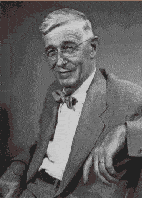|
Consider a future device for individual use, which is a sort of mechanized private file and library. It needs a name, and to coin one at random, “memex” will do. A memex is a device in which an individual stores all his books, records, and communications, and which is mechanized so that it may be consulted with exceeding speed and flexibility. It is an enlarged intimate supplement to his memory. It consists of a desk, and while it can presumably be operated from a distance, it is primarily the piece of furniture at which he works. On the top are slanting translucent screens, on which material can be projected for convenient reading. There is a keyboard, and sets of buttons and levers. Otherwise it looks like an ordinary desk. – Vannevar Bush; As We May Think; Atlantic Monthly; July 1945.
|
Vannevar Bush established the U.S. military / university research partnership that later invented the ARPANET, and wrote the first visionary description of the potential use for information technology, inspiring many of the Internet‘s creators.
Vannevar Bush was born on March 11, 1890, in Everett, Massachusetts. He taught at Tufts University from 1914 to 1917, carried out submarine-detection research for the US Navy, and then joined the faculty of the Massachusetts Institute of Technology (MIT) at the age of twenty-nine. At MIT, Bush worked with a team of researchers to build an automated network analyzer to solve mathematical differential equations, and in the 1930’s helped build the first analog computers.
President Roosevelt appointed Bush to Chairman of the National Defense Research Committee in 1940 to help with World War II. In 1941, Bush was appointed Director of the newly created Office of Scientific Research and Development (OSRD), established to coordinate weapons development research. The organization employed more than 6000 scientists by the end of the war, and supervised development of the atom bomb. From 1946 to 1947, he served as chairman of the Joint Research and Development Board.
Bush brought together the U.S. Military and universities with a level of research funding not previously deployed, providing the universities with large, new revenue streams for establishment of laboratories, acquisition of equipment, and the conduct of pure and applied research. In return, the military obtained the advantages of rapidly improving technology.
Thanks in part to Bush’s initial setup, the three lead universities in this partnership for several decades were Harvard University, the Massachusetts Institute of Technology, and the University of California at Berkeley. Through the influence of projects like SAGE and organizations like the IPTO, the university / military partnership established by Bush naturally laid the foundation for subsequent development of the ARPANET by DARPA.
However, Vannevar Bush’s most direct influence on the development of the Internet comes from his visionary description of an information system he called “memex”, in an article titled As We May Think published in the Atlantic Monthly in July, 1945, in which he describes the first automated information management system (see excerpt top of this page).
Bush’s memex was a breakthrough revelation, an information centric application of electronic technology not previously considered. The vision stamped by memex strongly inspired succeeding generations of scientists and engineers who built the Internet, notably J.C.R. Licklider and Douglas Engelbart. Many leading researchers realized that a memex type system would eventually be built, and worked to help realize it. Only now, more than 50 years later, has Bush’s dream become fully realized with the development of personal computers, the web, internet service providers, and search engines.
In the private sector, Vannevar Bush was a cofounder of Raytheon, one of the United State’s largest defense contractors. He was also president of the Carnegie Institute of Washington research organization from 1939 to 1955.
Resources. The following sites provide additional information on Vannevar Bush.
- Bush, Vannevar; Science The Endless Frontier; A Report to the President by Vannevar Bush, Director of the Office of Scientific Research and Development; United States Government Printing Office; July, 1945.
- Memex and Beyond — historical and current research in hypermedia inspired by Vannevar Bush’s memex vision.
